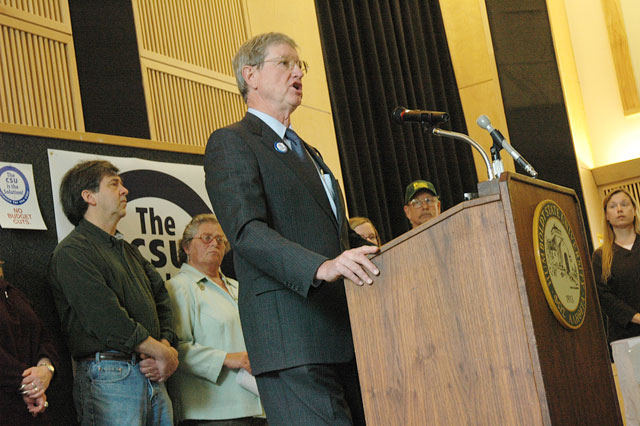To learn more about budget cuts concerning Humboldt State University visit the following:
| The Alliance for the CSU campaign |
| Campus budget news and information |
| Humboldt State Advocacy Center |

Again and again, speakers at an all-campus forum prodded the audience to grasp the budget crisis in personal terms, not as an abstract accounting problem in distant Sacramento.
If the CSU campaign to turn the state budget around is to be successful, declared Student Representative Sarah Shoenberger, “It must become personal. This is your education, your job,” she told attendees. “This is your child’s education 10 years from now, this is the health of Arcata, [and] the health of Humboldt County. This issue doesn’t affect just students, this affects everybody.”
HSU President Rollin Richmond noted that the University provides the county with a $301 million economic return and 8,000 jobs.
Leaders asked everyone to pass word of the threatened cuts to parents, families, siblings, friends, neighbors and alumni. “Alliance for the CSU” is asking them to contact their lawmakers and make their opposition known. “Getting them [to take action] makes it personal,” Shoenberger underscored. She and others insisted that strong collective action could head off the cuts.
The budget crisis may inflict another 10% student fee hike, amounting to $73.2 million system-wide. “This is a tax on you,” Shoenberger exclaimed. “I can’t even make enough money in the summer to pay for a semester of college. That should be taken personally!”
Sounding the same note, Tim Moxon, Director of Plant Operations, explained how decaying buildings and postponed maintenance directly affect students’ lives. He cited rainy weather and delayed roof repairs that can force classroom shutdowns. “It’s incredibly expensive to repair the damage from a leaky roof,” he said, likening HSU’s ominous situation to the car owner who fails to replace the brake pads for $150.00, damages the rotors and winds up paying $750.00.
Physical plant is as crucial to students as books and computers, yet “by every standard of the CSU, Humboldt State is below average in every area of maintenance,” Moxon warned. He recalled that the number of plant ops employees stood at 160-plus in 1979; in the nearly 30 years since, their ranks have plunged more than 50%, to about 75. Yet the number of square feet to be maintained and operated has jumped to 1.2 million from 900,000.
Accordingly, students, alumni, faculty, staff, administrators, union leaders and political officials thronged the Kate Buchanan Room to denounce the proposed spending reductions as “irrational,” “short-sighted,” “devastating” and “senseless.” They labeled the impact on higher education a grave threat to California’s already skidding economy.
Humboldt County Supervisor and HSU Alum John Woolley zeroed in on the literally millions of hours of volunteer community service that students and faculty donate to the Redwood Coast, through agencies such as Y.E.S. (Youth Education Services), which Woolley helped to found. “It used to be [said] that, ‘Where California goes, so goes the nation;’ I say, ‘Where Humboldt goes, so goes California,’” he averred. “I’ve never seen back-to-back cuts like we’re seeing to date being proposed. This is devastating to the moral attributes we believe in as far as education goes. This is not right.”
In post-rally interviews with reporters, President Richmond laid out a timetable for how his administration will grapple with the $7.3 million reduction for Fiscal 2008-2009, which starts July 1. He will “very shortly” inform the Academic Senate, the University Budget Committee, Staff Council and Associated Students of his proposals and recommendations to meet the cuts. He will solicit their suggestions and counterproposals. “My guess is we’re about a month away or so from having at least a preliminary program for what we’re going to have to do next year,” he predicted.
The president emphasized, however, that the state deficit is a moving target—current estimates run from $17 billion to $24 billion—and the pressures on HSU’s budget might worsen. Among a multitude of unknowns is the ultimate depth of the sub-prime mortgage crisis, which he noted is hitting California particularly hard and exacerbating the state deficit.
There is also the uncertainty surrounding the governor’s so-called “May-revise”—the updated budget presentation the governor makes to the legislature in the spring.
Asked if students should begin planning to change majors or drop out for a year and get a job in view of the academic programs that may be on the chopping block, Dr. Richmond said his imminent reduction plan would, as far as possible, skirt “significant cuts” to academic affairs in Fiscal 2008-2009. He pointed to the months-old initiative to set new priorities for academic programs. He also mentioned his work with the vice presidents to prioritize the non-academic units in their divisions. Both efforts will take more time, and in the meanwhile, “We’re going to try our very best to protect Academic Affairs,” he said.